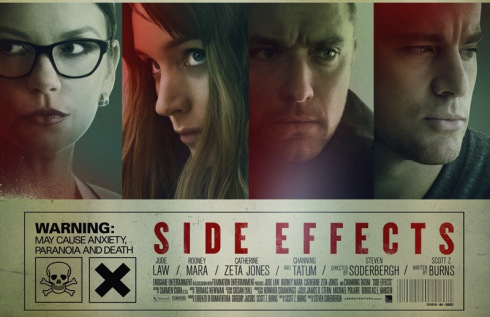By Kelly Patricia O’Meara
March 6, 2013
 Steven Soderbergh’s “psychological thriller,” Side Effects, very clearly demonstrates two things: the fraud and criminality of psychiatric diagnosing.
Steven Soderbergh’s “psychological thriller,” Side Effects, very clearly demonstrates two things: the fraud and criminality of psychiatric diagnosing.
The “cat’s out of the bag” about the numerous convoluted twists and turns that make up what Rex Reed called “a tank of twaddle called Side Effects.” And, rather than guess, much to his credit, Reed was honest enough to admit, “I have seen it twice, and I still don’t know what it’s about.” Fair enough. It’s easy to see how anyone could be confused about the underlying story line.
Aside from the razzle-dazzle of yammering on about every antidepressant known to man (including a new and fictitious antidepressant called Ablixa), some very brief blather about the adverse side effects of the new psychiatric drug, psychiatrist/patient sexual abuse and, oh yeah, a bloody murder scene, there really isn’t anything new to get excited about.
That is until one considers that psychiatric diagnosing is behind every element of the story. And it is with this element that issues need to be considered if one is to truly appreciate the gift that Soderbergh has given his audience.
Interestingly enough, the day the filmed opened, Time.com published an interview with Dr. Sasha Bardey, a forensic psychiatrist who also happened to be a co-producer of the film. Bardey had worked in the prison ward of Bellevue Hospital in New York City and it was there that he met Scott Burns, the writer of Side Effects.
Bardey was asked in his interview with Time.com if the events in the movie were based on real cases. “Yes,” says Bardey, “they were either based on – or inspired by – actual cases. But most of the action you see in the movie is derived from real incidents that occurred.” Wow, this is some admission. The action you see in the movie is based on real incidents?
 Let’s review just two of the “real incidents.” First, Mara Rooney’s character, a frail and pale Emily, goes to a psychiatrist (Jude Law) telling him “every afternoon at three, there’s this poisonous fog bank, rolling in on my mind.”
Let’s review just two of the “real incidents.” First, Mara Rooney’s character, a frail and pale Emily, goes to a psychiatrist (Jude Law) telling him “every afternoon at three, there’s this poisonous fog bank, rolling in on my mind.”
Naturally, the psychiatrist (Law), by simply listening to pathetic Emily, determines she is suffering from depression and decides to “treat” her with antidepressants.
Okay, this is reality. Soderbergh, with the help of his real-life forensic psychiatrist, Bardey, has made it abundantly clear that a psychiatric diagnosis is nothing more than an opinion formed by the doctor listening to a patient.
What apparently was lost on the reviewers of this film and probably the viewing audience, is that every single psychiatric diagnosis is determined in the same manner. There is no science…no blood tests, no X-rays, no CAT scans or MRI’s to determine whether there’s an actual abnormality in the brain.
In other words, whether someone is diagnosed with depression, bipolar, ADHD, schizophrenia or any of the other 400 alleged mental illnesses, the psychiatrist merely has to briefly listen to the patient’s life complaints and, voila, the psychiatrist is able to determine the exact alleged mental disorder.
On the surface it is ridiculous and Soderbergh/Bardey have provided a very good example of the fraud that is psychiatric diagnosing, and the psychiatric fraud gets worse as the movie progresses.
Emily is prescribed several antidepressants. Her psychiatrist (Law) tells her that the drugs that regulate Serotonin “stop the brain from telling you to feel sad.” Really? Sounds like typical psychobabble on par with the never-proven “chemical imbalance,” theory and certainly there is no science to support such a claim.
For example, Eli Lilly, the maker of the first Selective Serotonin Reuptake Inhibitor, Prozac, wrote: “Depression is not fully understood, but a growing amount of evidence supports the view that people with depression may have an imbalance of the brain’s neurotransmitters, the chemicals that allow nerve cells in the brain to communicate with each other. Many scientists believe that an imbalance in serotonin, one of these neurotransmitters, may be an important factor in the development and severity of depression. Prozac may help correct this imbalance by increasing the brain’s own supply of serotonin.”
Sounds scientific, right? But no part of Lilly’s explanation provides a definitive explanation of depression or how Prozac effects depression. It does say that the pharmaceutical giant doesn’t understand depression, people may have a chemical imbalance, scientists believe and Prozac may help. In other words, there is no science to support the drug’s marketing claims.
Lilly wrote this nonsense thirty years ago. Since then scientists have not come any closer to figuring out what effect an increase in the brain’s serotonin levels has on depression or any other alleged mental illness.
In fact, it is becoming more clear, based on recent studies of clinical trial data for all of the antidepressants on the market, that the drugs are only marginally better than a placebo (sugar pill).
By all accounts, no scientist has yet to prove that there is any chemical imbalance in the brain of any person, least of all depressed people. Worse, yet, there isn’t even a test available to determine chemical levels in the brain, making it impossible for anyone to know if there is an imbalance.
 Anyway, back to Emily. The first antidepressants she is prescribed don’t “work” and her psychiatrist (Law) takes advice from Emily’s previous psychiatrist (Catherine Zeta-Jones), who also happens to be Emily’s lesbian lover, and decides to prescribe the newest antidepressant, Ablixa.
Anyway, back to Emily. The first antidepressants she is prescribed don’t “work” and her psychiatrist (Law) takes advice from Emily’s previous psychiatrist (Catherine Zeta-Jones), who also happens to be Emily’s lesbian lover, and decides to prescribe the newest antidepressant, Ablixa.
Ablixa apparently has “side effects” which can cause people to sleepwalk and, in this drug induced state, become unaware of their behavior and actions. Depressed and drugged Emily kills her husband, claiming she has no memory of the event and she is the victim of the drug.
The audience then is fast-forwarded to the courtroom where Emily’s psychiatrist (Law) is Emily’s psychiatric expert who argues the drug made his client kill. Ultimately, Law convinces Emily to take an insanity plea, do a brief stint in a mental ward and, as he will determine when she is “better,” he will have her out in no time.
Again, it is the psychiatrist who not only diagnosed Emily as depressed and prescribed the mind-altering drugs, but it’s the same psychiatrist who now rescues her from criminal charges that surely would have her spending life in prison. The psychiatrist’s “expertise” will convince the court that Emily is innocent of murder.
But like the original depression diagnosis, the psychiatrist has no scientific tools, nothing other than his opinion, to come to his new conclusions of the patient’s behavior. And, based on an opinion, a psychiatrist could just as easily convince a court that the patient is not insane.
What is most troubling, though, is that Emily’s psychiatrist (Law) figures out that Emily faked her depression, never took the prescribed drugs and premeditated her husband’s murder.
To exact revenge for the personal and professional trouble Emily caused to psychiatrist Law, he arranges to have her committed to a mental institution where only he will decide when she is “better.” And, the movie leaves the audience with a view of a pathetic and drugged Emily apparently spending the rest of her life behind the walls of the mental institution.
So here’s the question, if Bardey is being honest when he says the events in this movie are based on real cases, then one has to wonder who is the real-life patient that has been committed to a mental institution because the psychiatrist wanted revenge?
Equally important, who is the real-life psychiatrist who is keeping someone in a mental institution with the full knowledge that the patient does not suffer from any alleged mental illness?
The point, which this movie abundantly demonstrates, is that psychiatric diagnosing is a fraud and, because of that fraud…because there is no science to back up a single mental illness diagnosis, a psychiatrist can literally get away with criminal behavior.
This is not Hollywood. This is real-life as there are nearly 2 million involuntary commitments occurring in the U.S. every year. Bardey apparently is aware of one such involuntary and seemingly criminal commitment that most would agree is in desperate need of review.
Arguably, there may be others who are wondering how many other commitments Bardey is aware of that are the result of a psychiatrist’s personal agenda?
Kelly Patricia O’Meara is an award winning investigative reporter for the Washington Times, Insight Magazine, penning dozens of articles exposing the fraud of psychiatric diagnosis and the dangers of the psychiatric drugs – including her ground-breaking 1999 cover story, Guns & Doses, exposing the link between psychiatric drugs and acts of senseless violence. She is also the author of the highly acclaimed book, Psyched Out: How Psychiatry Sells Mental Illness and Pushes Pills that Kill. Prior to working as an investigative journalist, O’Meara spent sixteen years on Capitol Hill as a congressional staffer to four Members of Congress. She holds a B.S. in Political Science from the University of Maryland.


SHARE YOUR STORY/COMMENT